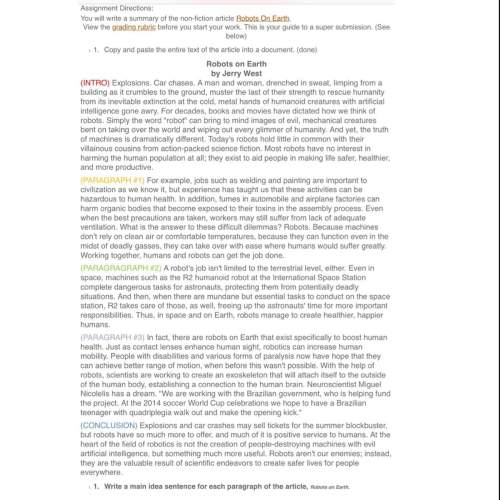
English, 11.03.2021 17:20 gfdsgfd5654
ONLY IF ITS RIGHT In "The New Colossus," we discovered that the author used an allusion. In this allusion she references another statue that existed long ago. How is the statue from the allusion different from the statue being described in the poem? Be sure to use evidence from the poem the states how each statue is different from the other.
For this response you need to use the RACE writing strategy.
R- Restate the Question
A- Answer the question
C- Cite evidence from the text. You MUST use an exact quote from the poem to support your answer.
E- Explain the evidence - In this sentence, be sure that you are showing how the two statues are opposite from one another.
Con - Give a conclusion.
The New Colossus
Not like the brazen giant of Greek fame,
With conquering limbs astride from land to land;
Here at our sea-washed, sunset gates shall stand
A mighty woman with a torch, whose flames the imprisoned lightning, and her name
Mother of Exiles. From her beacon-hand
Glows world-wide welcome; her mild eyes command
The air-bridged harbor that twin cities frame.
“Keep, ancient lands, your storied pomp!” cries she
With silent lips. “Give me your tired, your poor,
Your huddled masses yearning to breathe free,
The wretched refuse of your teeming shore.
Send these, the homeless, tempest-tost to me,
I lift my lamp beside the golden door!” ❖brazen bold; also, literally made of brass
pomp showy displays meant to be impressive
refuse things to be discarded; things considered to have no value
teeming full tempest a violent storm

Answers: 3
Another question on English

English, 21.06.2019 21:40
What is the most likely the cumulative impact of the use of the word depict or depictions
Answers: 2

English, 22.06.2019 01:10
Read the passage from animal farm. as clover looked down the hillside her eyes filled with tears. if she could have spoken her thoughts, it would have been to say that this was not what they had aimed at when they had set themselves years ago to work for the overthrow of the human race. these scenes of terror and slaughter were not what they had looked forward to on that night when old major first stirred them to rebellion. if she herself had had any picture of the future, it had been of a society of animals set free from hunger and the whip, all equal, each working according to his capacity, the strong protecting the weak, as she had protected the lost brood of ducklings with her foreleg on the night of major's speech. instead—she did not know why—they had come to a time when no one dared speak his mind, when fierce, growling dogs roamed everywhere, and when you had to watch your comrades torn to pieces after confessing to shocking crimes. there was no thought of rebellion or disobedience in her mind. she knew that, even as things were, they were far better off than they had been in the days of jones, and that before all else it was needful to prevent the return of the human beings. whatever happened she would remain faithful, work hard, carry out the orders that were given to her, and accept the leadership of napoleon. but still, it was not for this that she and all the other animals had hoped and toiled. it was not for this that they had built the windmill and faced the bullets of jones's gun. such were her thoughts, though she lacked the words to express them. what was most likely orwell’s purpose for writing this passage? to show that clover is more sensitive to violence than the others to remind readers of major's speech and the original rebellion to present napoleon as a cruel leader unworthy of the animals’ support to represent misled followers and their dashed hopes for better lives
Answers: 3

English, 22.06.2019 07:30
Which method of characterization does the author use to the reader get to know mrs. allison? actions appearance dialogue thoughts
Answers: 1

English, 22.06.2019 07:50
She took up a scalpel and slit the monkey's abdomen, making a slow and gentle cut, keeping the blade well away from her gloved fingers. the spleen was puffed up and tough, leathery, like a globe of smoked salami. she did not see any bloody lesions inside this monkey. she had expected that the monkey's interior would be a lake of blood, but no, this monkey looked all right, it had not bled into itself. if the animal had died of ebola, this was not a clear case. she opened up the intestine. there was no blood inside it. the gut looked okay. then she examined the stomach. there she found a ring of bleeding spots at the junction between the stomach and the small intestine. this could be a sign of ebola, but it was not a clear sign. it could also be a sign of simian fever, not ebola. therefore, she could not confirm the presence of ebola virus in this animal based on a visual inspection of the internal organs during necropsy.
Answers: 3
You know the right answer?
ONLY IF ITS RIGHT In "The New Colossus," we discovered that the author used an allusion. In this all...
Questions



Physics, 24.07.2019 04:00

Mathematics, 24.07.2019 04:00



Physics, 24.07.2019 04:00



Mathematics, 24.07.2019 04:00






English, 24.07.2019 04:10


Biology, 24.07.2019 04:10





